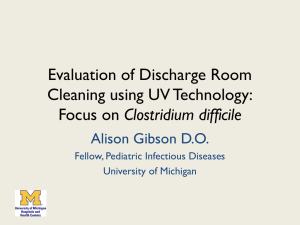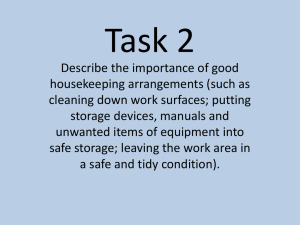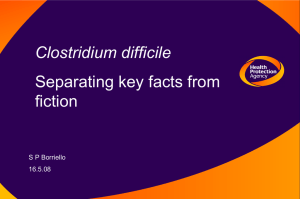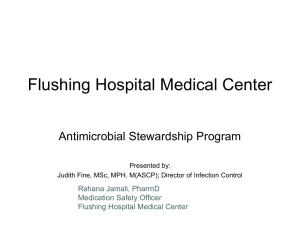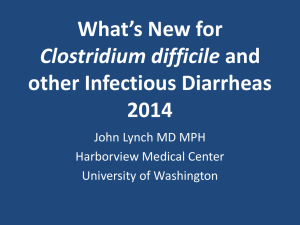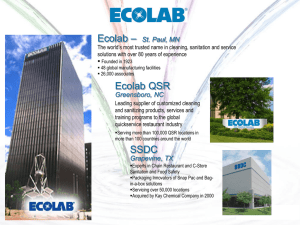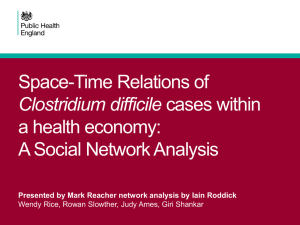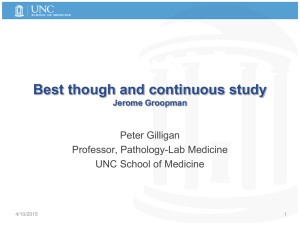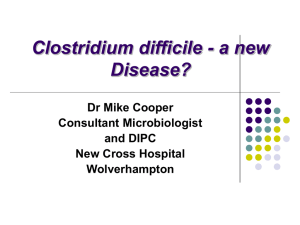C. Diffile Prevention Control - Multi
advertisement
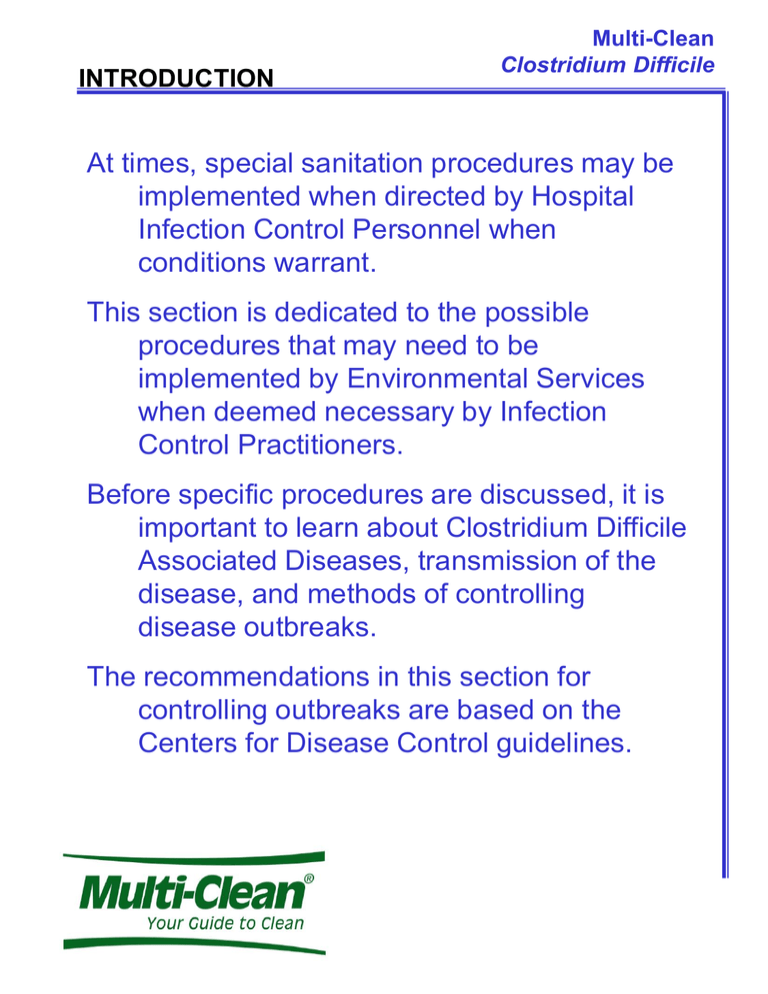
INTRODUCTION Multi-Clean Clostridium Difficile At times, special sanitation procedures may be implemented when directed by Hospital Infection Control Personnel when conditions warrant. This section is dedicated to the possible procedures that may need to be implemented by Environmental Services when deemed necessary by Infection Control Practitioners. Before specific procedures are discussed, it is important to learn about Clostridium Difficile Associated Diseases, transmission of the disease, and methods of controlling disease outbreaks. The recommendations in this section for controlling outbreaks are based on the Centers for Disease Control guidelines. What is it? Multi-Clean Clostridium Difficile Clostridium difficile (C. Difficile) is a bacteria that causes diarrhea and more serious intestinal diseases. C. Difficile Associated Diseases (CDAD) are serious and in severe cases cause death. The bacteria is found in feces and is transmitted among patients who come in contact with contaminated instruments, surfaces or on the hands of health care workers. Source: CDC www.cdc.gov/ncidod/dhqp/id_CdiffFAQ_HCP.htm l Multi-Clean C. Difficile Associated Diseases Transmission People in good health usually don’t get the disease. C. Difficile Associated Diseases (CDAD) are almost always associated with people that are undergoing prolonged anti-biotic therapy in a hospital environment. Sensitive individuals can become infected if they touch items or surfaces that are contaminated with feces and then touch their mouth or mucous membranes. Healthcare workers can spread the bacteria to other patients or contaminate surfaces with contact. C. Difficile bacteria produce spores as a defense mechanism. In the spore form, the bacteria is not growing or reproducing, but it very difficult to kill. When favorable conditions exist, the spores can revert back to the growing and reproducing state (called the “vegetative state”). Multi-Clean C. Difficile Associated Diseases Prevention Prevention: The CDC recommends normal sanitation with an EPA registered hospital disinfectants for general use in patient care areas. Special attention should always be paid to areas that may become feces contaminated. Multi-Clean Century Q 256 is a broad spectrum hospital grade disinfectant for general cleaning and sanitation in patient and OR areas. Currently there are no EPA registered disinfectants with demonstrated efficacy toward C. Difficile spores. There are disinfectants that are effective against C. Difficile in the vegetative state, including Micro-Cide TB from Multi-Clean. These disinfectants can offer an added measure of protection to help prevent CDAD when used in patient care areas for general cleaning. However, CDAD is usually spread by the spore form of C. Difficile, and therefore it should be duly noted that Microcide TB does NOT inactivate these spores. Reference: www.cdc.gov/ Multi-Clean C. Difficile Associated Diseases Control Control: If an outbreak of CDAD occurs, Infection Control Practitioners may implement specialized control measures to prevent the spread of C.Difficile. These control measures may include isolation procedures and contact precautions for patients with known or suspected CDAD, special hand hygiene protocols for healthcare staff, and implementation of an environmental cleaning and disinfectant strategy . Multi-Clean C. Difficile Associated Diseases Quality and Safety Environmental Cleaning and Disinfectant Strategy Safety: For the safety of yourself and others, you must use the proper personal protective equipment (PPE). Special equipment and procedures are required for isolation rooms. Quality: For C. Difficile outbreaks, meticulous cleaning is extremely important. Properly diluted solutions, clean uncontaminated equipment, and thorough attention to detail are required. Areas you may have cleaned may be tested for the presence of C. Difficile to determine adequacy of the cleaning process. Multi-Clean C. Difficile Associated Diseases Control Environmental Cleaning and Disinfectant Strategy If an outbreak of CDAD occurs, the cleaning and disinfectant strategy is to inactivate C. Difficile bacterial spores. There is evidence to suggest that bleach (hypochlorite) solutions are effective at inactivating C. Difficile spores. Therefore, the CDC advises the use of EPA registered hypochlorite solutions after meticulous cleaning of environmental surfaces. If generic forms of household bleach are used, user does so at their own risk. A 1:9 dilution for generic forms of household bleach is commmon, although stronger dilutions may be used.. Note: Bleach solutions are rapidly inactivated by organic soil. Bleach solutions can also degrade with time. Therefore solutions must be changed daily. Any procedure using bleach should be on pre-cleaned surfaces only. It may be advised to test solutions using chlorine test papers to insure the active content is being maintained. Reference. http://www.cdc.gov/ncidod/dhqp/id_CdiffFAQ_HCP.html#10 Multi-Clean C. Difficile Associated Diseases Control Environmental Cleaning and Disinfectant Strategy Procedures A. Dedicated mops and equipment are usually required. Also, never bring a cleaning cart into a room with suspect or known cases of CDAD. B.Use cleaning cloths pre-soaked in a solution of Century Q 256 (properly diluted) to clean environmental surfaces. Surfaces should remain wet after cleaning and allowed to air dry. C. After environmental surfaces have dried, use cloths that have been soaked in the hypochlorite (bleach) solution. If the product is an EPA registered disinfectant, use according to label instructions. Reference. http://www.cdc.gov/ncidod/dhqp/pdf/guidelines/Enviro_g uide_03.pdf Multi-Clean C. Difficile Associated Diseases Control Environmental Cleaning and Disinfectant Strategy Frequency of Cleaning A more intensive cleaning process is warranted when cleaning the rooms of isolated patients whether the room is occupied or between patients. The intensive cleaning process should occur once per day for occupied rooms of isolated patients. This includes cleaning of all environmental surfaces, complete restroom cleaning, with special attention to any surface that may come into contact with feces. Reference. http://www.cdc.gov/ncidod/dhqp/pdf/guidelines/Enviro_g uide_03.pdf

